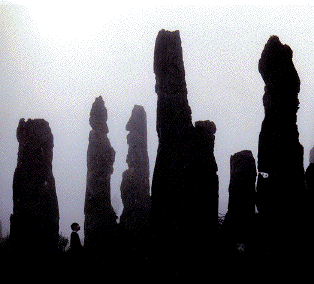

When rain falls, some of the water runs off, some evaporates, and the remainder soaks into the ground. The amount of water that follows each of these paths varies greatly as a function of factors such as:
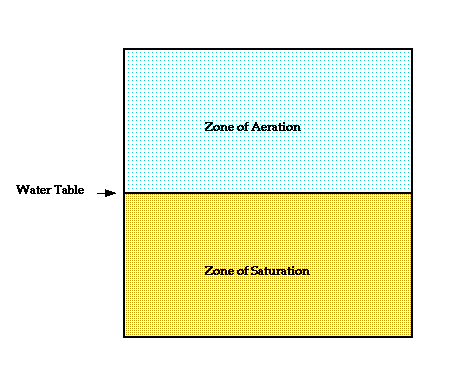 Some of the water that soaks into the ground adheres to particles in the soil - the belt of soil moisture. Water not held in this belt migrates downward until it reaches a zone in which the pore spaces in the material are completely filled with water - the zone of saturation or the vadose zone. Pores in the overlying zone of aeration are filled with a mixture of air and water. The contact between these two zones is the water table.
Some of the water that soaks into the ground adheres to particles in the soil - the belt of soil moisture. Water not held in this belt migrates downward until it reaches a zone in which the pore spaces in the material are completely filled with water - the zone of saturation or the vadose zone. Pores in the overlying zone of aeration are filled with a mixture of air and water. The contact between these two zones is the water table.
Rarely is the water table a flat, planar surface. The water table tends to rise beneath hills and to subside beneath a valley. If water is withdrawn from the zone of saturation at a greater rate than it is replenished, the water table will migrate downward with time. If, on the other hand, the rate of replenishment exceeds the rate of removal, the water table will migrate upwards. If the water table intersects the surface of the Earth, a spring will form.
A small quantity of the water found beneath the water table is juvenile water that has migrated upward from deeper within the Earth. Most, however, originates from the downward migration of rain water.
Tarbuk and Lutgens (1998) estimate that approximately 14% of the fresh water of the hydrosphere is stored as water beneath the Earth's surface.
Minerals vary widely in their chemical response to groundwater. Calcite, for example, is highly soluble in a weak acid such as H2CO3 - carbonic acid. Carbonic acid can form by a reaction between water and carbon dioxide. Rainwater is a weak acid (pH ~ 6). Thus, limestones which consist primarily of calcite (CaCO3) are vulnerable to chemical attack by groundwater. Dolomite (CaMg(CO3)2, on the other hand are considerably less soluble.
Are You Prepared To Continue?
Caverns
Most caverns are created at or just below the water table in the zone of saturation in limestones. If the water table is stable, large openings can be created by dissolving the limestone. If the water table drops, the area of active cave formation will move lower into the bedrock and the upper openings are abandoned as they are now in the zone of aeration. Water dripping through these abandoned passages may deposit CaCO3 in various forms collectively referred to as speleothems.
Time did not permit a visit to one of the numerous caves in the Stone Forest region so a few pictures from the Shenandoah Caverns in Virginia will have to suffice as a brief introduction to cave formations.
| Shenandoah Caverns, Virginia | Cave Formations |
|---|---|
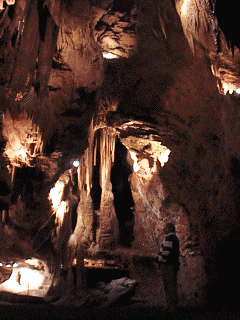 | 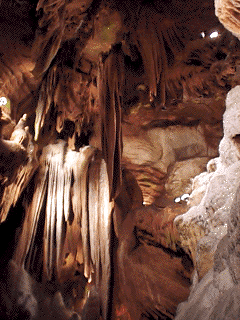 |
| Ribbon or Bacon Rock | Flow Stone |
|---|---|
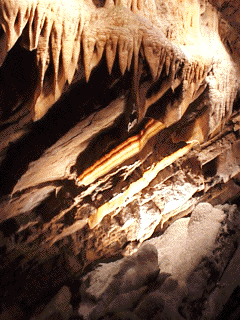 | 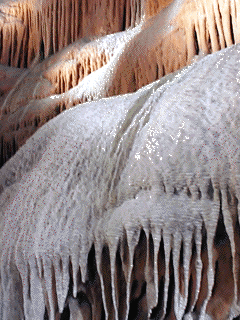 |
Karst Topography
| Sinkhole Lakes in Central Florida |
|---|
While some sinkholes form slowly by solution of the underlying carbonate rock, other sinkholes develop as a result of the collapse of surface or near-surface material. There are two basic types of sinkhole-forming collapses:
Imagine a situation in which a cavern begins to form at depth. Continued percolation of groundwater through the network of pore spaces or along fractures enlarges the cavern upwards. Eventually the roof of the cavern approaches the surface and a sinkhole may form. Watch the following animation to see one way in which a sinkhole can form.
Return To Table of Contents